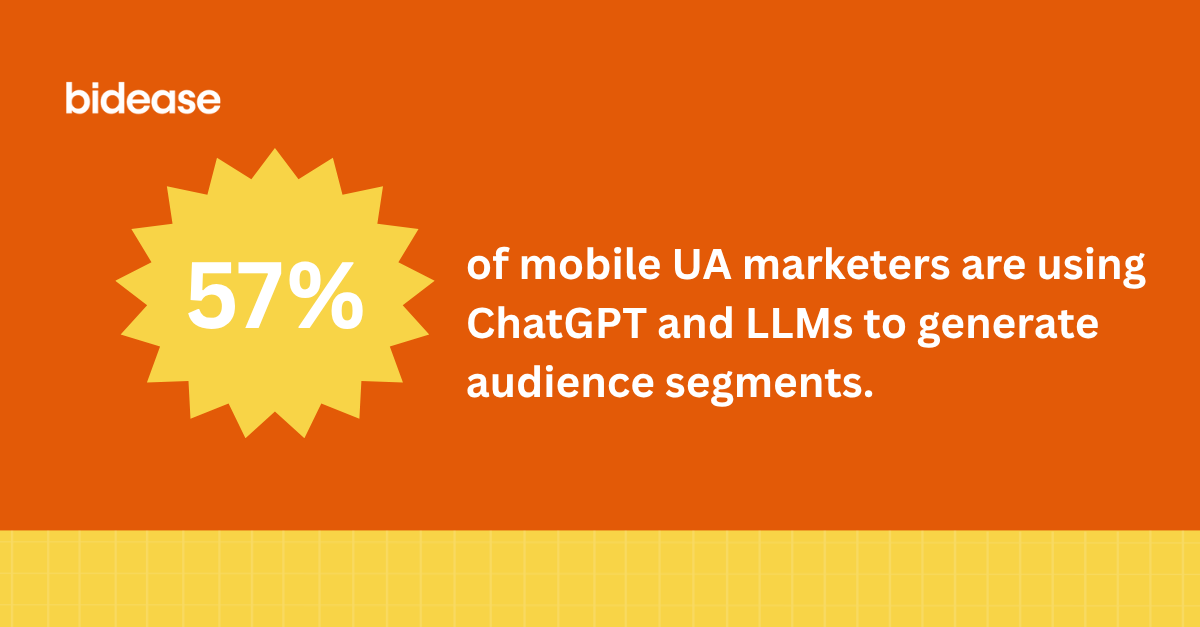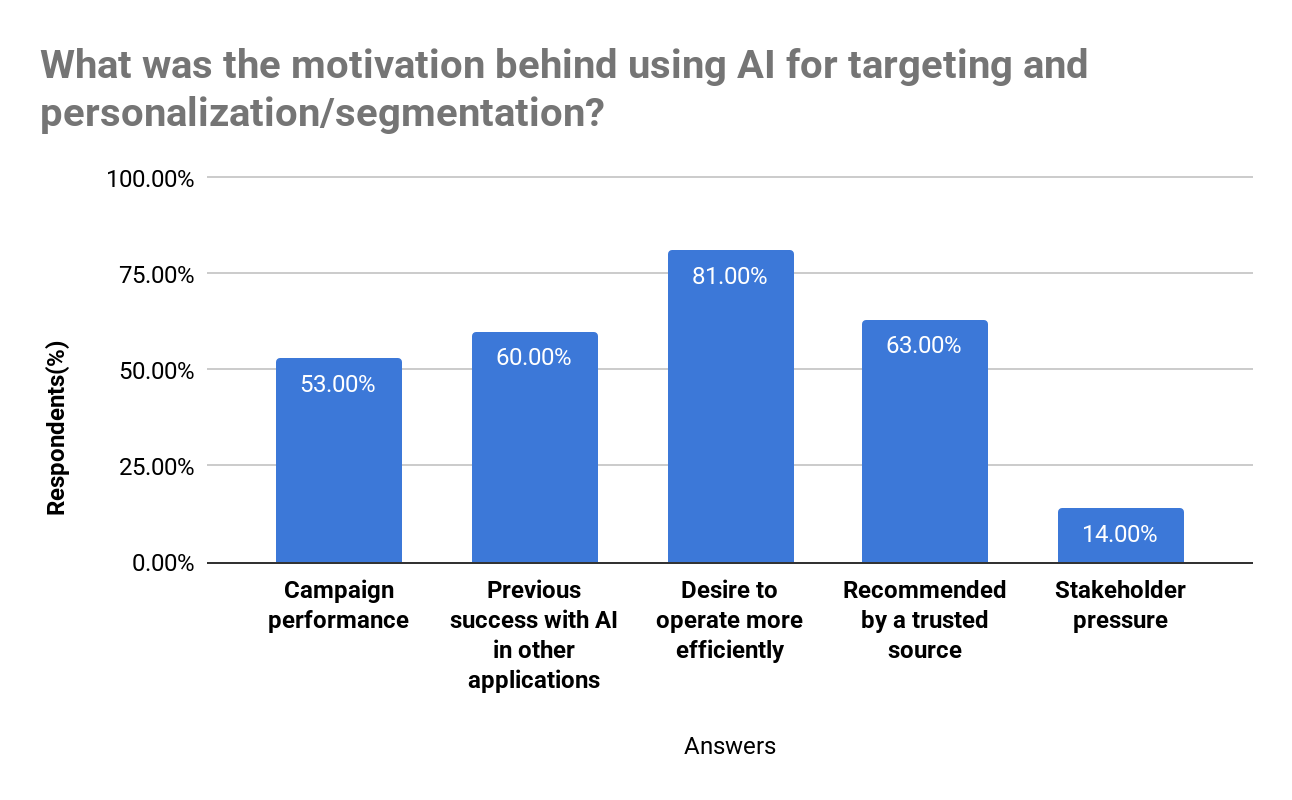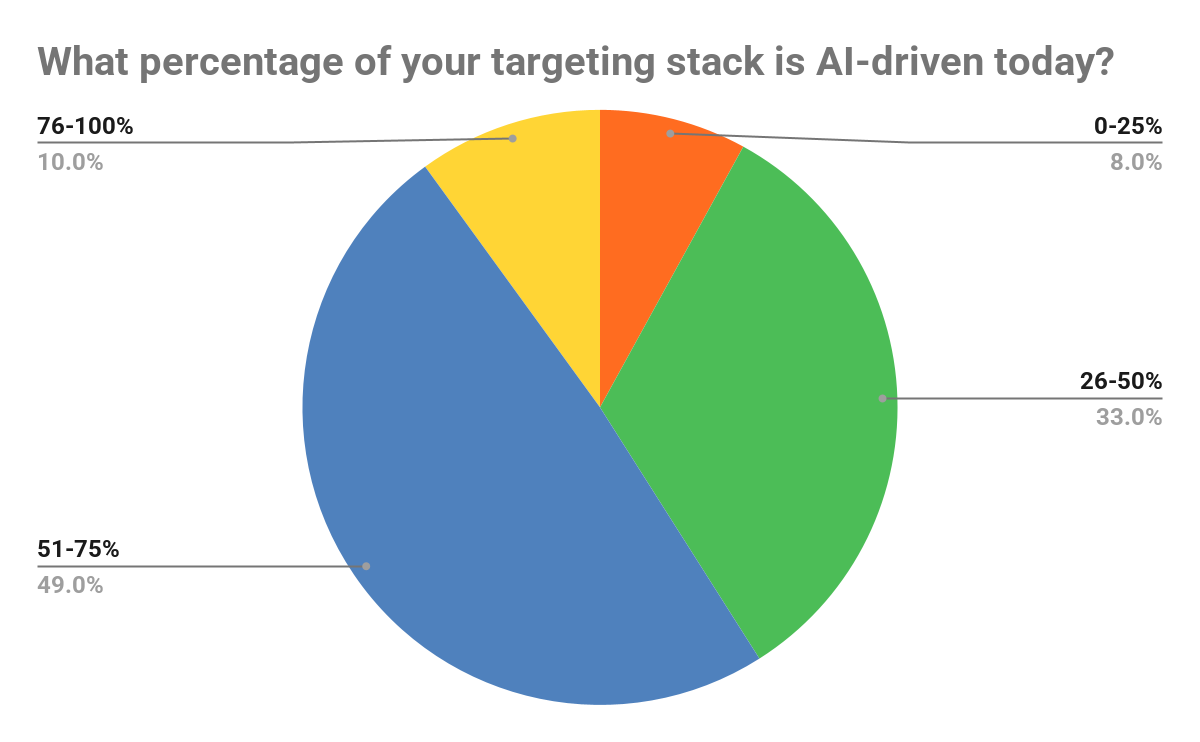How Mobile UA Teams Use AI for Segmentation & Personalization

As part of our ongoing research into how app marketers adapt to an evolving landscape of technology, data, and strategy, Bidease surveyed 100 UA professionals to uncover what’s really changing behind the scenes. Each post in this series highlights one insight shaping the future of programmatic growth — straight from the marketers driving it.
User acquisition managers face a more challenging environment than ever. With fewer reliable signals for targeting and an expanding mix of channels, partners, and platforms to oversee, they’re managing greater complexity with less clarity. But AI is changing how audiences are defined, understood, and reached. By automating segmentation, clustering, and prediction tasks, AI in targeting is freeing up human marketers to focus on strategy, storytelling, and measurement. To understand how marketers are navigating this shift, we surveyed 100 app growth marketers to explore how they’re balancing these competing demands, achieving results, and overcoming obstacles to scalable results.
Key Takeaway:
- Invest in cleaner, more connected first-party data to power smarter segmentation and targeting. AI can only deliver its full potential when it’s fueled by consistent, high-quality data that turns audience understanding into performance gains.
Why AI for Audience Targeting?

Mounting pressure to do more with less has driven marketers to double-down on efficiency-first mindsets. With AI offering convenient ways to maximize budgets and take care of the legwork for resource-intensive tasks, it’s an obvious solution for becoming more efficient. And for most marketers we surveyed, efficiency is a top priority: 81% of respondents cited the desire to operate more efficiently as their primary motivation for adopting AI in these areas.
To achieve these goals, marketers are using large language models (LLMs) like ChatGPT or Claude to process first-party data and uncover audience insights that fuel advanced segmentation and contextual targeting. According to our data, 57% of respondents use AI to generate insights from first-party data, supporting more precise clustering, real-time personalization, and privacy-conscious targeting strategies, as well as replicating those strategies across channels.
Other motivations reveal growing confidence in AI’s capabilities: 60% pointed to previous success with AI in other applications, and 63% said they adopted it based on a trusted recommendation. While improved campaign performance (53%) remains important, the emphasis on efficiency underscores how AI is being embraced both as a performance enhancer and as a necessary tool for managing today’s operational complexity.
“AI is making marketers’ strategies sharper. When teams let AI handle the heavy lifting of pattern recognition, they gain the space to think more creatively about strategy and storytelling.”
Dennis Mink, CMO of Bidease
AI Targeting Is Driving Results

Although AI is a relatively new addition to most marketing stacks, it’s already becoming foundational for segmentation and targeting. More than half of UA managers (59%) report that more than half of their targeting stack is AI-driven, while another 41% say AI powers up to half of their efforts.
Those who integrate AI into their strategies are reaping the rewards. An impressive 76% of marketers report increases in LTV and/or ROAS, and 62% have seen stronger ad relevance from improved audience segmentation and creative alignment. These gains in long-term value show that AI is rapidly evolving from a testing tool to the backbone of segmentation strategy, delivering higher returns and clearer insights into why campaigns succeed.
“AI is moving from a testing tool to the backbone of segmentation strategy. Teams using it for targeting are seeing higher returns and clearer insight into why campaigns succeed, creating a feedback loop that continually improves results.”
Dennis Mink, CMO of Bidease

However, in the same way that you can’t make a good movie from a bad script, you can’t create good audience segments without quality data. To that end, 78% of marketers are using GA4 and web-to-app data to help unify user journeys and connect fragmented engagement signals. First-party data (53%) remains essential for privacy-safe targeting and long-term resilience, while CRM and CDP data (44%) continue to grow in importance as teams merge customer lifecycle and campaign insights.
Traditional attribution sources such as SKAN postbacks and MMP data (33%) still contribute value but are increasingly supplemented by richer, owned data to fill gaps left by privacy restrictions. Third-party data (28%) now plays a smaller role, reflecting the industry’s decisive shift toward transparent, controllable, and compliant ecosystems.
“GA4 and web-to-app data give marketers back some clarity that privacy changes have taken away. When AI can see how users move across different touchpoints and channels in real time, it makes better predictions, which is when real efficiency begins.”
Dennis Mink, CMO of Bidease
We Recommend: Prioritize Data Hygiene and Scale
For all its promise, scaling AI in user acquisition still hinges on one critical factor: data quality and volume. Nearly a quarter of UA managers (23%) identified this as their biggest roadblock to expanding AI-driven personalization and segmentation.
Interestingly, traditional barriers like proving incrementality or securing organizational buy-in barely registered as major challenges, together accounting for less than 7% of respondents. That suggests that most organizations already recognize AI’s value in targeting and optimization and are ready to adopt and invest further, provided they have a strong data foundation. In short, the appetite for AI is high, but the constraint is clean, comprehensive, and connected data. Here’s how you can stay ahead of these challenges:
- Map where your data comes from and how it’s structured. Unify naming conventions, remove duplicates, and align event taxonomies across platforms like GA4, MMPs, and CRMs to ensure AI models receive consistent, reliable inputs.
- Implement automated quality checks. Set up recurring scripts or dashboards to flag anomalies such as missing fields, sudden volume drops, or schema drift. A lightweight monitoring system ensures your AI models are always fed clean, up-to-date data that reflects real user behavior.
- Consolidate your cleaned data. Use one repository or table that both marketing and data science teams use. Centralizing access reduces versioning errors, accelerates experimentation, and ensures every AI model trains on the same trusted foundation.
Be Part of the Shift
As AI continues to mature, the divide between teams that treat it as a shortcut and those that treat it as infrastructure will widen. The former will see incremental gains; the latter will see compounding ones. For now, the message is clear: the marketers getting the most out of AI are using it to make smarter audiences. If you want to start leveraging powerful AI tools, contact Bidease today. We offer automated spend management and precise optimization tools to ensure your campaigns deliver the best results. Get started today.
Customer retention is the key
Lorem ipsum dolor sit amet, consectetur adipiscing elit lobortis arcu enim urna adipiscing praesent velit viverra sit semper lorem eu cursus vel hendrerit elementum morbi curabitur etiam nibh justo, lorem aliquet donec sed sit mi dignissim at ante massa mattis.
- Neque sodales ut etiam sit amet nisl purus non tellus orci ac auctor
- Adipiscing elit ut aliquam purus sit amet viverra suspendisse potent
- Mauris commodo quis imperdiet massa tincidunt nunc pulvinar
- Excepteur sint occaecat cupidatat non proident sunt in culpa qui officia
What are the most relevant factors to consider?
Vitae congue eu consequat ac felis placerat vestibulum lectus mauris ultrices cursus sit amet dictum sit amet justo donec enim diam porttitor lacus luctus accumsan tortor posuere praesent tristique magna sit amet purus gravida quis blandit turpis.

Don’t overspend on growth marketing without good retention rates
At risus viverra adipiscing at in tellus integer feugiat nisl pretium fusce id velit ut tortor sagittis orci a scelerisque purus semper eget at lectus urna duis convallis porta nibh venenatis cras sed felis eget neque laoreet suspendisse interdum consectetur libero id faucibus nisl donec pretium vulputate sapien nec sagittis aliquam nunc lobortis mattis aliquam faucibus purus in.
- Neque sodales ut etiam sit amet nisl purus non tellus orci ac auctor
- Adipiscing elit ut aliquam purus sit amet viverra suspendisse potenti
- Mauris commodo quis imperdiet massa tincidunt nunc pulvinar
- Adipiscing elit ut aliquam purus sit amet viverra suspendisse potenti
What’s the ideal customer retention rate?
Nisi quis eleifend quam adipiscing vitae aliquet bibendum enim facilisis gravida neque euismod in pellentesque massa placerat volutpat lacus laoreet non curabitur gravida odio aenean sed adipiscing diam donec adipiscing tristique risus amet est placerat in egestas erat.
“Lorem ipsum dolor sit amet, consectetur adipiscing elit, sed do eiusmod tempor incididunt ut labore et dolore magna aliqua enim ad minim veniam.”
Next steps to increase your customer retention
Eget lorem dolor sed viverra ipsum nunc aliquet bibendum felis donec et odio pellentesque diam volutpat commodo sed egestas aliquam sem fringilla ut morbi tincidunt augue interdum velit euismod eu tincidunt tortor aliquam nulla facilisi aenean sed adipiscing diam donec adipiscing ut lectus arcu bibendum at varius vel pharetra nibh venenatis cras sed felis eget.
Related articles
Browse all articlesLet's Talk
We're Here to Help
Start your free consultation today. Create a custom growth strategy with a Bidease specialist.



